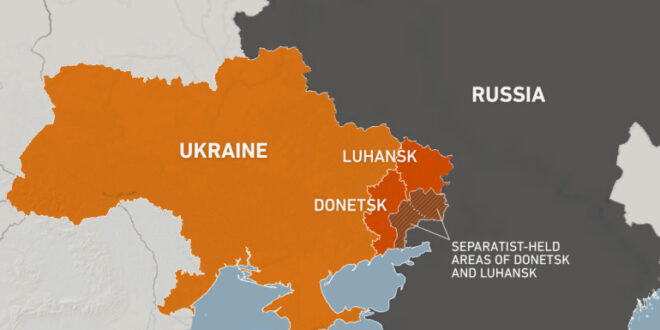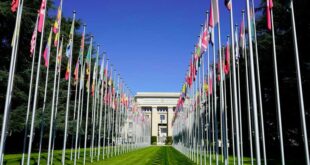Giancarlo Elia Valori
Ukraine, the EU and the United States have often interacted with one another and the crisis in Donbass is difficult to stop as the situation on the Russian-Ukrainian border has been overheated since mid-March. On April 13, the Ukrainian Foreign Minister participated in the extraordinary meeting of the NATO-Ukraine Committee and held talks with NATO Secretary General Jens Stoltenberg and U.S. Secretary of State Tony Blinken, hoping to gain the NATO countries’ support in the confrontation with Russia.
On the same day, U.S. President Biden spoke with his Russian counterpart Putin. President Biden reiterated U.S. support for Ukraine and proposed to hold a Summit in a third country over the next few months to comprehensively discuss the current issues facing the two countries.
The reason why the parties have fallen into such a tense situation is obviously related to the historical conflict between Ukraine and Russia. Since early 2021, the Ukrainian government has taken a number of actions on issues such as the situation in Eastern Ukraine and relations with Russia.
Photos circulated by Reuters news agency and some social media showed that the Russian troops gathered at the border had anti-aircraft missile systems such as Doyle and Beech, as well as some tanks and armoured vehicles.
BBC, Reuters, Associated Press and other major Western media officially reported that Russia had recently sent a large number of troops to the Eastern border areas of Crimea and Ukraine.
Faced with that tense situation, the Ukrainian government has often taken internal and external actions and it has also intensified its interaction with the Turkish and U.S. governments.
On April 2, President Biden spoke for the first time with the Ukrainian President, the populist and former actor, Volodymyr Oleksandrovych Zelens’ky, who said he would not allow his country to face Russia’s pressure alone when the situation in Eastern Ukraine escalated and worsened.
On April 5 the State Department spokesman, Edward Price, accused the Russian army of gathering large numbers of troops on the Russian-Ukrainian border and asked for explanations from the Russian side. Furthermore, the U.S. Navy had planned to send two warships to the Black Sea through the Bosporus from April 14 to 15 but, on April 15, the Turkish side stated that the plan had been cancelled.
With specific reference to Turkish-Ukrainian relations, President Zelensky visited Turkey on April 10 and met with Turkish President Erdoğan to discuss the situation in Eastern Ukraine, as well as other issues. President Erdoğan also stressed that Turkey supported Ukraine’s territorial integrity and sovereignty, and his position was not to recognise the annexation of Crimea, which the idiot Khrushchev gifted to Ukraine after a drink in 1954, less than a year after Stalin’s death. Considering his narrow-mindedness and crass ignorance, he did not understand that the Stalinist Constitution of December 5, 1936 had a well-founded legal basis and also respected the secession of the USSR Republics (Article 17: “Every federated republic retains the right of free secession from the USSR”). As is well known, the first destructive consequence of alcohol is the loss of mind control.
Moreover, the recent military cooperation and interaction between Ukraine and Turkey has also raised much concern. According to Al Jazeera, in 2018 Ukraine purchased 6 Turkish-made TB2 unmanned aerial vehicles (UAV) and 200 precision-guided weapons for a total price of 69 million dollars. On March 15, 2021, several C-17 transport aircraft flew from Turkey to Ukraine, carrying weapons and equipment.
According to the report, in the recent conflict over Nagorno-Karabakh, Ukraine sent military experts to closely monitor how the Azerbaijani army used those Turkish-made drones. Some of them said they found that the Azerbaijani army’s war methods “have a lot in common” with the Ukrainian government forces’ war against militants in the East.
On April 13, the military news website Defense Blog reported that the TB2 drone had been deployed near Donbass, while Russian Foreign Ministry’s officials lodged a public protest.
It is worth noting that Turkey was only the first stop on the foreign visit paid by populist President Zelensky. He also met with French President Macron. Beforehand, the leaders of Germany and France had held a video conference with Russian President Putin. President Zelensky’s spokesman commented that all parties should not exclude Ukraine before making any decisions on it.
According to the White House, President Biden expressed concern about the Russian military presence on Ukraine’s border and urged President Putin to de-escalate tension. The White House concluded: “President Biden stressed the firm commitment of the United States to the sovereignty and territorial integrity of Ukraine. The Kremlin underlined: “During the exchange of views on Ukraine’s internal crisis, President Putin outlined the basis for the measures of the “Minsk package” (ceasefire agreement) of February 12, 2015 as a political solution”.
For this reason, in July 2020, the tripartite contact group on Ukraine (Ukraine, Russia and the Organisation for Security and Cooperation in Europe) held a video conference with representatives of the civilian armed forces in the Donbass region, Eastern Ukraine, in view of achieving a comprehensive ceasefire in the region so as to reach an agreement later.
Nevertheless, since the end of February 2021, incidents and casualties have increased in Eastern Ukraine. Ukrainian government forces and civilian armed forces in the East have accused each other of breaking the ceasefire agreement.
The Ukrainian government said in late March that the gathering of Russian troops in its border areas posed a severe threat to national security. Conversely, the Russian side believes that it is precisely because the military forces of NATO countries and other parties are becoming more active in areas close to the Russian border that Russia has been forced to remain vigilant, ensuring stability and security on its border.
During that period, the Russian side had reactions that surprised the West. In addition to information on troop mobilisation that was intensively reported in the Western media, Russia also sent more intense signals through media channels. Russia Today publicly raised the issue of “Russian Donbass” for the first time while participating in the “Russia-Donbass” Forum on January 28, 2021. Russia stressed that it was not excluded to bring back the “Crimea model” in desperate situations and directly control the Donbass region.
In support of Ukraine, President Biden’s Administration reversed former President Trump’s decision to withdraw troops from Germany on April 13. Meanwhile, both U.S. Defense Secretary Lloyd James Austin III and Secretary of State Blinken visited European countries in the first half of April. On April 13 Austin announced that, in addition to halting the withdrawal, the United States would send 500 additional soldiers to Germany. Asked whether the move was designed to conveying a message to Russia, Austin said he was “sending a signal to NATO” to show the U.S. commitment to the transatlantic alliance and to Germany.
At the same time, Blinken met with NATO allies in Brussels and held a separate meeting with Ukrainian Foreign Minister Dmytro Ivanovyč Kuleba. Blinken told him: “The United States firmly supports Ukraine’s territorial integrity and sovereignty.” And the Minister replied that Ukraine urgently needed NATO’s help.
It should also be noted that NATO continued to provide assistance to Ukraine. On March 10, a delegation of NATO ground force Commanders, led by NATO Lieutenant General Roger Cloutier, arrived in Ukraine. According to an earlier report on the Ukrinform news website, the Ukrainian army commented that the trip demonstrated that NATO regarded Ukraine as a “strategic partner”.
According to Secretary General Stoltenberg, NATO is currently providing various forms of aid to the Ukrainian army, including training, joint exercises and military modernisation. Although Ukraine is not a NATO Member State, it has obtained Western weapons such as the Javelin anti-tank missile through various channels.
We wonder whether a third world war is worth it, in case of an invasion of the Russian geopolitical area by NATO? Is it worth having at least 4-5 billion dead people and a devastated planet taken back in time, with whom the 20 million dead of World War II would seem like a car crash by comparison? And for what? For old inter-ethnic hatred that third parties would like to exploit for their own benefit, probably believing they are countering the Panamanian or Grenadian army?
Suppose the People’s Republic of China sent an expeditionary force – with Navy units and missiles – to its friendly Mexico: what do you think would happen?
 Geostrategic Media Political Commentary, Analysis, Security, Defense
Geostrategic Media Political Commentary, Analysis, Security, Defense





